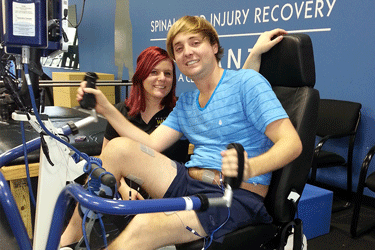An updated Cochrane review finds that stroke patients who participate in a post-stroke walking program walk faster, longer, and more independently than nonexercisers, says a statement released by Health Behavior News Service.
“Cardiorespiratory training, which used walking as the mode of exercise, can improve walking ability,” said lead review author David Saunders, PhD, a lecturer in exercise physiology at the University of Edinburgh in Scotland, in the statement.
Researchers looked at 24 studies that included 1,147 stroke patients. The analysis focused on how participation in fitness training programs after stroke influenced rates of death, dependence, or disability. Fitness training included cardiovascular exercise (walking or cycling), strength training (free weights or resistance bands), or a combination of cardiovascular and strength training.
A previous review hinted that cardiorespiratory training involving walking could be beneficial to stroke patients. In the current review, the increased number of randomized controlled trials “has strengthened the fairly cautious conclusions reported in 2004,” Saunders said.
The review appears in the current issue of The Cochrane Library, a publication of The Cochrane Collaboration, UK, an international organization that evaluates research in all aspects of health care. Systematic reviews draw evidence-based conclusions about medical practice after considering the content and quality of existing trials on a topic. Half of the trials took place in the United States.
Stroke often causes weakness or paralysis, muscle stiffness, balance problems, and fatigue, all of which can make it difficult to move easily.
Many stroke patients also had poor fitness or other chronic health conditions before stroke, which contributes to movement difficulties. According to the National Stroke Association, about 4 million Americans live with the aftereffects of stroke.
“If you ask stroke patients about aspects of function that are important for them to regain, walking and ambulation are repeatedly highly rated as being important to them,” Saunders said. “The most consistent pattern within our data related to cardiorespiratory training benefiting walking, in terms of maximum walking speed, comfortable walking speed, walking tolerance, and reliance on other people for ambulation.”
The study participants walked three or more days per week, usually for more than 20 minutes at a time.
In exercising patients, maximum walking speed increased by about 5.6 yards per minute, and patients could cover an additional 42.5 yards in a 6-minute session compared to nonexercisers, the authors reported in the review.
Whether these benefits persist after training is finished remains unclear, Saunders said.
Only four studies with 158 participants evaluated strength-training programs, which did not allow definitive recommendations, said the statement.
“If you strength-train stroke patients, you can make them stronger, but there was no evidence of improvement in mobility and physical function,” Saunders said.
In addition, most available studies in this review did not examine whether exercise programs influenced stroke patients’ level of disability. Only one person died in the included studies, so the study authors could not make conclusions about the effect of fitness training on death or disability rates.
“The conclusions are reasonable based on the published literature. The real challenge is that they are struggling with studies that are insufficient to answer the questions that they have posed,” said Joel Stein, MD, professor and chief in the division of rehabilitation medicine at Weill Cornell Medical College in New York City, and author of a book on recovering from stroke.
“The large, overarching point to be made is that exercise is good for you. There is a lot of evidence that exercise helps prevent heart disease, stroke, and obesity, and that it reduces the risk of developing diabetes," Stein said. "We have robust evidence that exercise is beneficial, but it is a little harder to cite proof that physical fitness training is good for stroke survivors in particular.”
Stein, who had no affiliation with the review, said that it is unclear whether performing exercise at the levels examined in the study is feasible for many stroke survivors. Studies such as those included in the review suffer from a bias because they rely on stroke survivors who are interested and able to participate. These stroke survivors might actually be more motivated and healthier than the average stroke patient, Stein said, which could skew results.
“For patients who are ambulatory, I advise walking as the simplest and most relevant exercise,” Stein said.
The Cochrane Library contains health care information, including systematic reviews from The Cochrane Collaboration. The Cochrane Collaboration is an international nonprofit, independent organization that produces and disseminates systematic reviews of health care interventions and promotes the search for evidence in the form of clinical trials and other studies of interventions.
Saunders DH, et al. Physical fitness training for stroke patients (Review). The Cochrane Database of Systematic Reviews 2009, Issue 4.
[Source: Health Behavior News Service]




